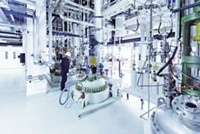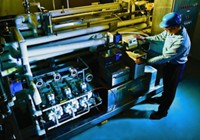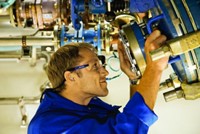Advertisement
Grab your lab coat. Let's get started
Welcome!
Welcome!
Create an account below to get 6 C&EN articles per month, receive newsletters and more - all free.
It seems this is your first time logging in online. Please enter the following information to continue.
As an ACS member you automatically get access to this site. All we need is few more details to create your reading experience.
Not you? Sign in with a different account.
Not you? Sign in with a different account.
ERROR 1
ERROR 1
ERROR 2
ERROR 2
ERROR 2
ERROR 2
ERROR 2
Password and Confirm password must match.
If you have an ACS member number, please enter it here so we can link this account to your membership. (optional)
ERROR 2
ACS values your privacy. By submitting your information, you are gaining access to C&EN and subscribing to our weekly newsletter. We use the information you provide to make your reading experience better, and we will never sell your data to third party members.
Business
Contract Manufacturing Firms Assess The Landscape
Custom chemical suppliers at Informex consider geography as they continue to expand their operations
by Ann M. Thayer
March 11, 2013
| A version of this story appeared in
Volume 91, Issue 10

Success in custom chemical manufacturing, as in many businesses, depends on three important factors—location, location, location. It is critical because location can dictate a company’s competitive position and attractiveness to customers. These concerns were on the minds of executives from custom chemical firms at last month’s Informex USA trade show, held in Anaheim, Calif.
Executives from firms serving the pharmaceutical industry reported having a generally strong year in 2012. But the manufacturing landscape continues to shift under the weight of economic, regulatory, and competitive challenges. Assessing where their companies sit geographically is factoring into executives’ decisions about how and where to expand business.
Ash Stevens is increasing its footprint in Riverview, Mich., through a nearly completed $12 million expansion. “We increased our workforce 10% last year and will do another 10% this year in part to support this large build-out,” Chief Executive Officer Stephen A. Munk said. “We received manufacturing approval late last year for an innovator drug, and we anticipate a couple more in the next two to three years. So we believe that manufacturing is very much alive in the U.S.”
Like other executives, Munk believes that U.S. active pharmaceutical ingredient (API) manufacturers are experiencing “a good uptick in business coming back to the West from Asia.” These customers are interested in good communication around project management and high levels of regulatory compliance, he said.
Irix Pharmaceuticals CEO J. Guy Steenrod described a related trend. Although almost everyone buys starting materials from Asia, “we are seeing situations where clients tell us they are just not willing to take their final steps of API synthesis to Asia,” he said. This attitude means more business at home for the South Carolina-based API firm, which anticipates increasing its workforce of about 150 by 10% this year.
Brian Scanlan, CEO of Wisconsin-based Cambridge Major Laboratories (CML), trusts that business is growing for U.S. API makers, but he’s not sure whether the growth reflects a return from offshore or simply different industry dynamics. “For years I have heard anecdotal comments about projects and business that have gone into Asia and started to trickle back, but I haven’t seen any hard numbers that would substantiate the assertion,” he commented.
Instead, the numbers that Scanlan and, he believes, others are seeing stem from a sharper focus by pharma customers on compounds in late-stage clinical trials, while preclinical and early-stage business remains anemic. For API makers, this shift translates into large product volumes and significantly bigger dollar-value contracts.
“Our highest revenue growth is in Phase IIB through commercial scale,” Scanlan said. This year, CML will complete a nearly 30% expansion of its three-year-old, large-scale plant in Wisconsin and add 41 people to the 160 who work at its two U.S. facilities. The company also operates a site in Europe.
Scanlan is confident that the calculated risks CML has taken to expand are worth it. Emerging companies, which make up about half the firm’s customers, are the least apt to send projects offshore, especially when they are betting on just one compound. “The smaller the company, and the fewer the assets they own, the more they look to U.S. or Western-based producers,” he added.
Precious-metal catalyst manufacturer Umicore, although based in Belgium, sees reasons to expand in the U.S. as well. To produce its full range of catalysts, it will add capacity at the Tulsa auto catalyst plant it acquired in 2007 from Delphi. The plant, which Umicore purchased for $56 million, had about 15,000 sq ft of space in which to expand, said Phillip M. Chalabi, director of business development.
By operating a more comprehensive catalyst plant in Tulsa, the company, which manufactures catalysts in Europe, Japan, and Latin America, will be better placed to serve major North American customers, Chalabi said. Customers want to increase supply chain efficiency, he said, as well as avoid import duties, which are extremely high for precious metals. It will phase out existing operations in South Plainfield, N.J.
Despite their bullishness, Western suppliers are concerned about their higher cost structure relative to Asian competitors, given that many big drug companies or firms with mature products are looking to cut costs. “If cost is the driver, then China and India will win, at least for today,” Munk pointed out. “If what you are after is quality and speed of delivery, I think the West has an advantage.”
Although cost will always be important, service and other value-adding capabilities can reduce the competitive threat. “We put a clear emphasis on technology and invest in ones that make sense,” said Aslam Malik, president of California-based Ampac Fine Chemicals. For example, labor costs are low for the firm’s large-scale, continuous simulated moving bed chromatography process, giving it room to be price competitive, he noted.
Executives expect that the Asian cost advantage will disappear, but they are uncertain about when. Salaries for workers in India and China are still about one-tenth those in the West, but productivity in Asia is a few times lower, explained Derek G. Hennecke, CEO of the Florida-based formulation firm Xcelience, citing data from the U.S. Bureau of Labor Statistics. In the end, however, India and China still come out ahead with overall costs one-third to one-fourth those in the West.
Whether there will be parity in 10, 15, or more years depends on how quickly operating costs rise. Donald Hou, head of process R&D and manufacturing services at China’s ShangPharma, expects that it might happen sooner rather than later. “There has been a lot of wage inflation in China,” he said, and stricter government policies also could increase costs.
But because the Chinese government requires products to be made in China if they are going to be sold there, many plants are being built, Hou said. Although these plants are intended to serve the Chinese market, they also can export. The major Chinese contractors that cater to U.S., European, and Japanese customers have all gotten big, he added.
Western pharma customers are still anxious about quality assurance and the scope of intellectual property (IP) protection in China, according to Hou, who spent more than 20 years in the U.S. drug industry. One of the greatest risks can come from Chinese suppliers’ own employees, he said, referring to a recent situation in which a service company worker stole and tried to sell a big U.S. customer’s compounds.

“The knee-jerk reaction was to pull back a lot of work from the company,” Hou said, and move manufacturing requiring current Good Manufacturing Practices (cGMP) to the U.S. Whereas big pharma companies, especially ones with their own facilities, may have the option to make changes, most emerging drug firms want to stay with U.S. or European suppliers they trust, he added. Executives agreed that for these customers speed, quality, and control over IP and product development are crucial.
“Emerging pharma companies are not ready to go to China to sell in China,” Hou added. “But over the next five to 10 years I think we will see more U.S. and European big pharma companies go to Asia to do cGMP manufacturing.”
In the meantime, companies such as the German specialty and custom chemical producer Allessa have no plans to spread out. “We are in Frankfurt, and will stay there,” said Michael Hassler, head of marketing and sales. “More so now than ever.”
Investment in Asian production would not benefit the company, Hassler said, because local Asian firms already serve customers that require supply from Asia. At the same time, there are fewer such customers, as Western companies that sought lower-priced products in Asia are no longer getting much of a bargain.
He also sees little competitive advantage in setting up production in the U.S. “Europe versus North America is not as important as the West versus Asia,” he believes. “The U.S. is becoming important again, but the assets there have consolidated.” As a result, Hassler sees few opportunities to expand in the U.S.
As the historical home of the fine chemicals industry, Europe has more large-scale capacity for small molecules than the U.S., which is home to more specialized firms, CML’s Scanlan explained. “Some of the old, tired capacity within Europe is being retrofitted or disabled, so there are limited and targeted investments in the European market,” he said. But he sees a continuing need for high-quality assets in the U.S. because of the local concentration of innovator pharma and emerging companies.
In general, executives are cautiously upbeat about investing further in the U.S. Scanlan warns companies against building an entirely new site in the U.S.—or anywhere, in fact—unless they have an established presence. Meanwhile, Malik advocates evaluating the economics of buying an existing plant, as Ampac did in 2010 when it bought a “pretty new facility at a pretty good price” in La Porte, Texas.
For Irix’ Steenrod, the decision to invest is grounded in having customers lined up. “In the past we invested on the potential of business coming in, but today it is more of what we can see,” he said. “I’d be sure you get a good bit of business locked up before you start putting money in the ground.”
With reporting by Rick Mullin





Join the conversation
Contact the reporter
Submit a Letter to the Editor for publication
Engage with us on Twitter